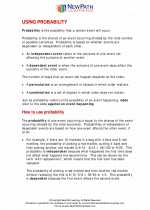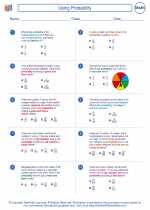Sequences of Numbers
A sequence is a list of numbers in a specific order. Each number in the sequence is called a term. The terms in a sequence are usually generated according to a pattern or rule. Sequences can be either finite (with a specific number of terms) or infinite (continuing indefinitely).
Types of Sequences
There are different types of sequences, including:
- Arithmetic Sequence: In an arithmetic sequence, each term is obtained by adding a constant value to the previous term. The constant value is called the common difference. The general form of an arithmetic sequence is: an = a1 + (n-1)d, where an is the n-th term, a1 is the first term, and d is the common difference.
- Geometric Sequence: In a geometric sequence, each term is obtained by multiplying the previous term by a constant value. The constant value is called the common ratio. The general form of a geometric sequence is: an = a1 * r(n-1), where an is the n-th term, a1 is the first term, and r is the common ratio.
- Fibonacci Sequence: The Fibonacci sequence is a special sequence where each term is the sum of the two preceding terms, starting with 0 and 1. The sequence begins: 0, 1, 1, 2, 3, 5, 8, 13, 21, and so on.
Common Notation
When working with sequences, it's important to understand common notation used to represent them:
- an: The n-th term of the sequence.
- a1: The first term of the sequence.
- d: The common difference in an arithmetic sequence.
- r: The common ratio in a geometric sequence.
Study Guide
To study sequences of numbers, it's important to:
- Understand the differences between arithmetic, geometric, and other types of sequences.
- Be able to identify the pattern or rule used to generate the terms of a sequence.
- Know how to find specific terms in a sequence, given the sequence type and its initial terms or common ratio/difference.
- Practice recognizing and generating sequences in various contexts, such as real-world problems or mathematical patterns.
- Explore the properties and behaviors of different types of sequences, including their sums and limits in the case of infinite sequences.
By mastering the concepts and skills related to sequences of numbers, you'll be well-prepared to tackle problems involving patterns, series, and mathematical modeling in various fields.
.◂Math Worksheets and Study Guides Seventh Grade. Using Probability
Study Guide Using Probability
Using Probability  Worksheet/Answer key
Worksheet/Answer key Using Probability
Using Probability  Worksheet/Answer key
Worksheet/Answer key Using Probability
Using Probability  Worksheet/Answer key
Worksheet/Answer key Using Probability
Using Probability 

 Worksheet/Answer key
Worksheet/Answer key
 Worksheet/Answer key
Worksheet/Answer key
 Worksheet/Answer key
Worksheet/Answer key

The resources above cover the following skills:
Data Analysis and Probability (NCTM)
Understand and apply basic concepts of probability
Compute probabilities for simple compound events, using such methods as organized lists, tree diagrams, and area models.